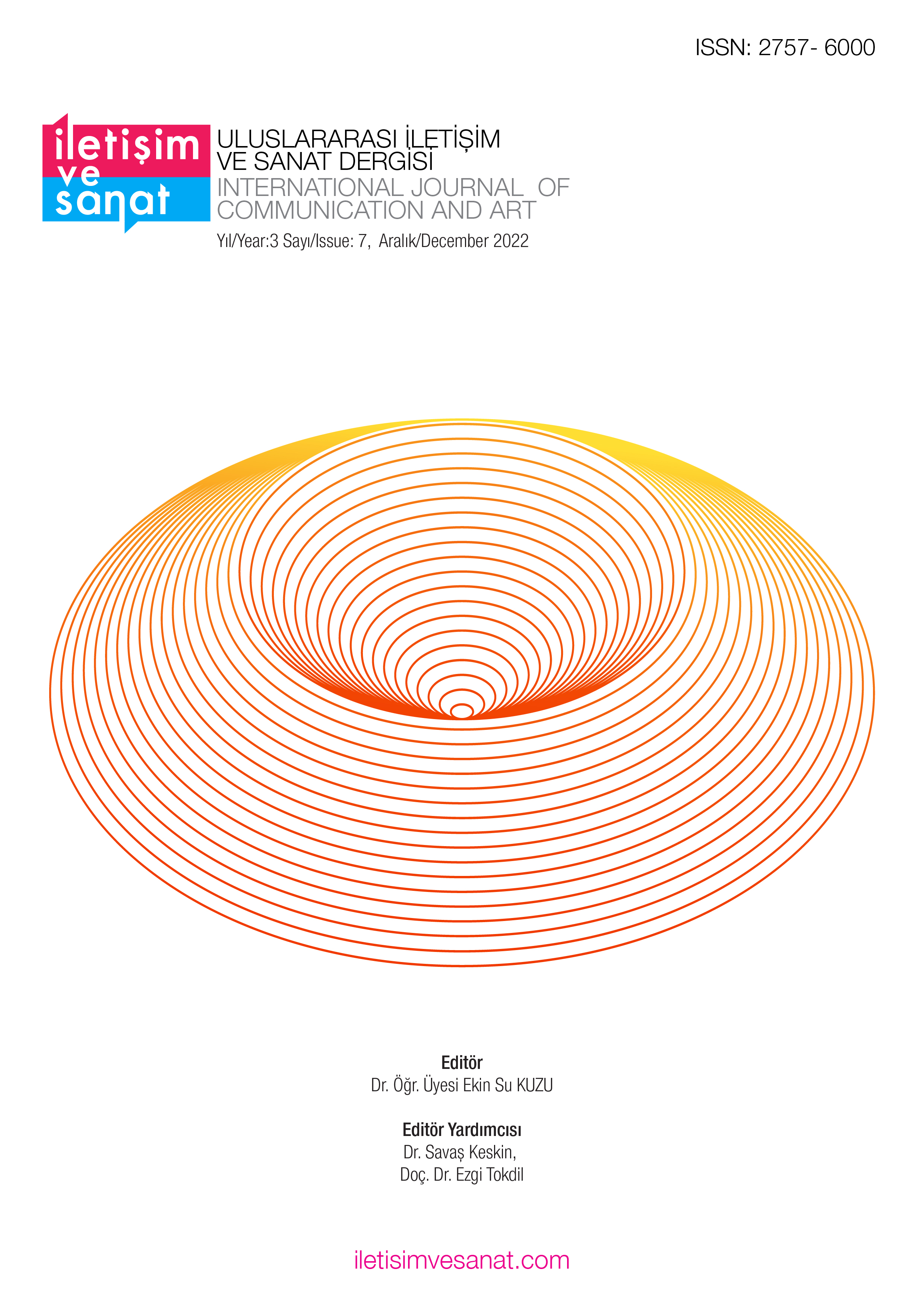Sanata Disiplinlerarası Bakış: Jean Dubuffet ve Rene Magritte’in Wittgenstein ve Popper Felsefesi ile İlişkiselliği
Author :
Abstract
Bu çalışmada paradigmatik değişimler sonucu ortaya çıkan yaklaşımlardan modernizm, postmodernizm ve bu yaklaşımların sanata kazandırdığı yeni olgular göz önünde bulundurularak, Rene Magritte ve Jean Dubuffet’in eserleri estetiğin konusu kapsamına giren güzel ve çirkin kavramları, modern düşünce biçimlerini ortaya çıkaran felsefi devinimlerle birlikte incelenmiştir. Ludwig Wittgenstein’ın dil felsefesi çerçevesinde Rene Magritte’in sanat yapıtlarındaki imgelem gücü “The Treachery of Images (İmgelerin İhaneti)” tablosu özelinde değerlendirilirken, bilim felsefesine yanlışlanabilirlik ilkesiyle yeni bir ivme kazandıran ve bilimin gerçeğe yanlışların ayıklanması yoluyla yaklaşacağını öne süren pozitivist filozof Karl Popper’ın ilkeleri özelinde “Bidon l'Esbroufe (Soytarı Kutu)” tablosu irdelenmiştir. Wittgenstein ve Popper’ın felsefeleri, 20. yüzyılda ortaya çıkan ve dil felsefesi ile bilim felsefesi alanlarında önemli etkiler bırakan düşünce yapılarıdır. Benzer şekilde Magritte’in İmgelerin İhaneti tablosu ile Dubuffet’in Soytarı Kutu tablosu da birbirine yakın dönemlerde ortaya çıkan ancak dönemsel olarak farklı biçimlendirme anlayışlarını temsil eden eserlerdir. Araştırmada iki eser arasındaki izleksellik, temel estetik kuramlar göz önünde bulundurularak güzel ve çirkin kavramları dahilinde tartışılmıştır. Betimsel içerik analizi yönteminin kullanıldığı çalışma, ilişkisel tarama modelinde nitel bir araştırmadır. Örnekleme alınan eserler amaçlı eleman örnekleme yöntemi ile evrenden örnekleme seçilmiştir.
Keywords
Abstract
In this study, the works of Rene Magritte and Jean Dubuffet, which are among the approaches that emerged as a result of paradigmatic changes, modernism, postmodernism, and the new phenomena brought by these approaches to art, are examined together with the philosophical movements that reveal the concepts of beauty and ugly, which are within the scope of aesthetics. In the framework of Ludwig Wittgenstein's philosophy of language, the power of imagination in Rene Magritte's works of art is evaluated in the context of the painting “The Treachery of Images”, while the positivist philosopher Karl Popper, who gave a new impetus to the philosophy of science with the principle of falsifiability and claimed that science would approach the truth through the elimination of errors. In particular, the painting “Bidon l'Esbroufe (The Jester Box)” has been examined in terms of the principles of. The philosophies of Wittgenstein and Popper are the structures of thought that emerged in the 20th century and left significant effects on the philosophy of language and philosophy of science. Similarly, Magritte's The Betrayal of Images and Dubuffet's Jester Box are works that emerged in close periods but represent periodically different understandings of shaping. In the research, the thematicity between the two works is discussed within the concepts of beauty and ugly, taking into account the basic aesthetic theories. The study, in which the descriptive content analysis method was used, is qualitative research in the relational screening model. Sampling was chosen from the universe with the purposeful element sampling method of the samples taken.
Keywords
- Alikılıç, İ. (2021). Pozitivizm ve Postpozitivizm. İnsanat Sanat Tasarım ve Mimarlık
- Alikılıç, İ. (2021). Pozitivizm ve Postpozitivizm. İnsanat Sanat Tasarım ve Mimarlık Araştırmaları Dergisi, 1(1), 39-62.
- Atalay, M. C., & Tüzün, M. (2017). Görsel Sanatlarda Paradoks. HUMANITAS-Uluslararası Sosyal Bilimler Dergisi, 5(10), 295-314.
- Alkayış, A. (2018). Dil Felsefesi Bağlamında Wittgenstein’in Tractatus Logico-Philosophicusile Felsefi Soruşturmalar Döneminin Karşılaştırılması. Uluslararası Anadolu Sosyal Bilimler Dergisi, 2(1), 35-47.
- Aytekin, C. A., & Altındağ, G. (2020). Sanatta Ölçülebilen Güzellik ve Sonsuz Olan Çirkinlik, Aksiyolojik Açıdan Güzel ve Çirkin Estetiği. Mecmua, (9), 111-125.
- Barışık A. (2018). Modernizm ve Postmodernizm Akımlarını Temel Alarak A. Çehov’un MartıEserinin Üretim Toplumundan Tüketim Toplumuna Geçiş Süreci FarkındalığıylaYorumlanabilmesi Üzerine Öneri. (Mimar Sinan Güzel Sanatlar Üniversitesi Güzel SanatlarEnstitüsü, Sanatta Yeterlilik Tezi) https://tez.yok.gov.tr/UlusalTezMerkezi/ adresinden (30.11.2022) tarihinde erişilmiştir.
- Batu, B. (2014). Sanat Yapıtı ve Dil Arasındaki Bağlantı. İdil Sanat ve Dil Dergisi, 3(14), 13- 26.
- Becermen, M. (2010). "Popper’ın Marx’ın tarih, toplum ve siyaset görüşünü eleştirisi üzerinebir inceleme". Kaygı. Uludağ Üniversitesi Fen-Edebiyat Fakültesi Felsefe Dergisi, 14, 45-59.Çelikbaş, E. Ö. (2020). Art Brut Hareketi ve Jean Dubuffet: Bir Sanat Terapisi Bağıntısı. Akdeniz Sanat, 14(25), 35-43.
- Dell'Atti, E. (2014). Language games in Magritte and Wittgenstein. Coordinamento Servizi İnformatici Bibliotecari di Atteneo. 82, 6-23
- Eco, U. (2004). Güzelliğin Tarihi. İstanbul: Doğan Kitapçılık.Edgü, F. (2005). Jean Dubuffet, İstanbul: Pera Müzesi Yayını.
- Farthing S. (2017). Sanatın Tüm Öyküsü. İstanbul: Hayalperest Yayınevi.Gümüş S. (2021). Modernizm ve Postmodernizm. İstanbul: Can Yayınları
- Hadot, P., & Erşen, M. (2011). Wittgenstein ve dilin sınırları. Ankara: Doğu Batı Yayınları.
- Karaçetin, B. (2013). 20. Yüzyılda sanatta ve klasik batı müziğindeki akımlar sonucu klarnettegelişen modern çalım teknikleri. (Mimar Sinan Güzel Sanatlar Üniversitesi Güzel SanatlarEnstitüsü, Sanatta Yeterlilik Tezi) https://tez.yok.gov.tr/UlusalTezMerkezi/ adresinden (28.11.2022) tarihinde erişilmiştir.
- Luis Alexandre Ribeiro Branco (2014). A Response to Jean-François Lyotard’s View ofPostmodernism And the Denial of The Metanarratives. e-kitap: Rakuten Kobo Bookshttps://www.kobo.com/tr/tr/ebook/jean-francois-lyotard-a-response-to-jean-francois-lyotard-
- s-view-of-postmodernism-and-the-denial-of-the-metanarratives sitesinden (10.12. 2022) tarihinde erişilmiştir.
- Maden, M. (2019). Karl Popper Felsefesinde Bilimsel Doğrular ve Yanlışlanabilirlik İlkesi. Akademi Sosyal Bilimler Dergisi, 6(17), 288-294.
- Özeskici, E. (2018). Sanatta değişen paradigmalar: Sanatçı, eser ve alıcı ilişkisi. Yedi, (20), 111- 120.
- Panova, E., & Osman, F. (2006). Wittgenstein’ın felsefi metamorfozu. Uludağ Üniversitesi İlahiyat Fakültesi Dergisi, 15(2).
- Popper, K. R. (2022). Daha İyi Bir Dünya Arayışı. İstanbul: Yapı Kredi Yayınları.Popper, K. R. (2022). Kesinlik Üstüne + Kültür ve Değer. İstanbul: Metis Yayınları
- Süzen, H. N. (2020). Art of the Jean Dubuffet Art Brut. Turkish Studies-Social Sciences, 15(6), 3117-3129.
- Utku, A. (2014). Ludwig Wittgenstein: Erken döneminde dilin sınırları ve felsefe. Ankara: Doğubatı Yayınları.
- Wittgenstein, L. (2009). Tractatus Logico Philosophicus. e-kitap: Gutenberg.https://www.kobo.com/tr/tr/ebook/tractatus-logico-philosophicus-2 sayfasından (14.11.2022) Yiğit, S. (2019). 'Çirkinin Estetiği'Olur mu? Söylem Filoloji Dergisi, 4(2), 592-600.
- Görsel 1. Rene Magritte, The Treachery of Images - https://www.renemagritte.org/the- treachery-of-images.jsp sayfasından (15.11.2022) tarihinde erişilmiştir.
- bilbao.eus/en/exhibition/bidon-lesbroufe sayfasından (15.11.2022) tarihinde erişilmiştir.





